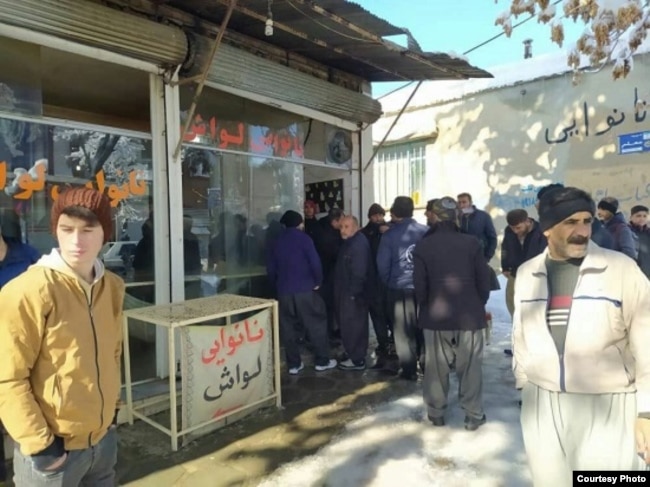RFL/RE – A dramatic rise in the price of flour in Iran is leading to concerns that the authorities’ recent decision to end subsidies for imported wheat could come at the cost of social unrest.
Since the Iranian government ended subsidies for imported wheat on May 1, the cost of flour has soared by around 500 percent and is expected to increase further. With the rising cost of flour, so too has the cost of staple foods like bread and pasta as well as confectioneries and other flour-based products, leading to images of empty shelves at bakeries and groceries.
The suddenness of the situation has led to warnings from lawmakers and loyalists to Iran’s clerical regime that mass protests could come next.
Many basic food items have become scarce in #Iran. Some bakeries have stopped making bread due to the high price of flour. #43YearOfMisery pic.twitter.com/LY5bSmCPor— Iran News Wire (@IranNW) May 5, 2022
The Student Basij, a subgrouping of the Basij militia that is itself a branch of Iran’s Islamic Revolutionary Guards Corps, issued a stark warning to hard-line President Ebrahim Raisi.
“We strongly inform you that society is not prepared for such a sudden increase in prices at this level,” the group said in a May 5 statement. “The turmoil in the markets in recent weeks, and especially the shocking decision by the Agriculture Ministry to increase the price of flour for industrial producers, could have social consequences and unrest.”
The statement described the move to end subsidies as a “serious shock” to trades and industries that depended on subsidized wheat and flour, and advised the government to refrain from making such decisions without considering public opinion first.
‘A Huge Mistake’
Reformist politician Jalil Rahimi Jahanabadi likewise slammed the decision, taking to Twitter to say that eliminating the subsidies and allowing flour prices to float to dollar-driven global rates “was a huge mistake by the government.”
“People’s threshold for tolerance,” he added, has already “been low for years.”
Many Iranians are struggling to make ends meet in an economy that has been crushed by crippling U.S. sanctions and years of mismanagement.
Iranians have been rocked by soaring inflation, which stands at about 40 percent, according to government statistics, and is believed to be even higher for food. Iranian media have reported that the price of rice, a staple whose rising costs in recent years had already driven many consumers to alternatives like bread, has risen by 130 percent. Bean prices, meanwhile, have reportedly soared by 120 percent, and the costs for cooking oil and sugar have also gone up.
To address a growing deficit, Raisi’s cash-strapped administration has looked to cut major government subsidies, including on pharmaceutical drugs.SEE ALSO:Iranians Express Alarm As Drug Prices Skyrocket Amid Plan To Cut Major Subsidy
But the government, which is currently working out Iran’s budget for the upcoming year, is also facing stark realities.
Mohammad-Reza Mortazavi, the head of Iran’s Flour Producers Association, said on May 2 that the country was more reliant than ever on foreign grain, and would have to import more than 20 million tons of grain in 2022.
Wheat imports account for about one-third of local demand, Mortazavi said, and with global wheat prices skyrocketing amid Russia’s invasion of Ukraine, a major wheat exporter, the foreign commodity will not come cheap.
With Ukrainian grain exports hampered due to the war and the reported theft of Ukrainian grain stocks, Mortazavi said that Iran could not expect the rising price of agricultural commodities to fall, and would increasingly turn to “Russia or the Baltic states, and even [Western] Europe” for supplies.
According to the Ports and Maritime Organization, Iran imported around 16.5 million tons of grain last year, about half of which was wheat and the rest was barley, corn, and rice.
Economic Difficulties
Iran is one of the top importers of grain from Russia, one of the world’s top wheat producers.
The two countries, each facing economic difficulties and trade barriers due to international sanctions, reportedly agreed in March on a deal that would see Iran import 20 million tons of foodstuffs and livestock fodder — including vegetable oil, wheat, barley, and corn — from Russia.
While a hike in subsidies for domestic grain producers is being considered for the next budget, set to the Iranian calendar, it would still mean that local suppliers would receive far less than Tehran is paying for imports.
Mortazavi of the Flour Producers Association said in late April that industrial bakeries and other food producers had been given advance warning about the impending loss of government subsidies, and the effect that the rising cost of flour would have on their products.

To alleviate concerns about rising prices, a senior Economy Ministry official announced on May 5 that a new program will be introduced under which consumers will be able to receive subsidized bread.
“When people buy bread, they pay the same price as before, and the government will pay for the difference,” said Ebrahim Siami, the general director of the ministry’s Department of Future Research, Planning, and Management.
Siami did not say when the new program would be launched, although it will reportedly start in the coming days.
The announcement followed Agriculture Minister Seyed Javad Sadatinejad’s pledge on May 4 that subsidies would be provided to compensate for the rising costs of flour.
Sadatinejad also echoed comments from other officials that wheat and flour were being smuggled out of the country, alleging that the subsidies had been lining the pockets of foreign neighbors.
‘Great Social Upheavals’
Warnings about the threat of public unrest are not unfounded.
Last summer, mass protests over water shortages in western Iran turned deadly. The authorities resorted to force to put down the demonstrations, which took place in multiple cities and lasted for days.SEE ALSO:Iran’s Angry Water Protests Turn Deadly Amid Severe Drought
The water shortages, a perennial problem in Iran, are seen as a result of extended drought and government mismanagement of water supplies, which hinder Iran’s agriculture industry.
In 2019, the government’s sudden decision to increase gasoline prices triggered protests in more than 100 Iranian cities and towns. The government responded with lethal force, with rights groups recording the deaths of more than 300 protesters and bystanders.
In January, conservative lawmaker Ahmad Naderi warned that the government was taking the wrong path by proposing to cut food subsidies in its efforts to tighten next year’s budget.
“I warn that if these approaches continue, we will reach a point where we will see great social upheavals,” he said.
- Michael ScollonMichael Scollon is a senior correspondent in RFE/RL’s Central Newsroom in Prague.[email protected] SUBSCRIBE VIA RSS
- RFE/RL’s Radio FardaRFE/RL’s Radio Farda breaks through government censorship to deliver accurate news and provide a platform for informed discussion and debate to audiences in Iran.
 Shabtabnews In this dark night, I have lost my way – Arise from a corner, oh you the star of guidance.
Shabtabnews In this dark night, I have lost my way – Arise from a corner, oh you the star of guidance.



